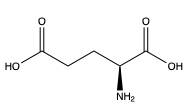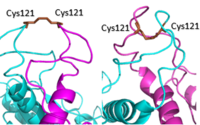Sandbox Reserved 1715
From Proteopedia
(Difference between revisions)
| Line 2: | Line 2: | ||
== Introduction == | == Introduction == | ||
| - | Within the central nervous system (CNS), various receptors exist to detect extracellular molecules and | + | Within the central nervous system (CNS), various membrane receptors exist to detect extracellular signaling molecules and communicate this information intracellularly. Found in eukaryotes and known for its seven transmembrane helices, [https://en.wikipedia.org/wiki/G_protein-coupled_receptor G-protein coupled receptor] (GPCR) are one type of membrane bound receptors with conserved intracellular signaling via heterotrimeric G-proteins. The metabotropic glutamate receptor (mGlu), a Class C GPCR, is a receptor utilized in glutamate signaling- which is essential in synaptic plasticity as well as the development and repair of the CNS. These receptors are specifically found in the pre- and postsynaptic neurons of the CNS. Eight different mGlu subtypes exist which are divided into three groups (I, II, III). While each mGlu has a slightly different function and location, the structures of the different mGlu subtypes are very similar (Table 1) <ref name="Niswender">PMID:20055706</ref>. For each group, binding of the neurotransmitter glutamate to the mGlu introduces a conformational change that can activate a G-protein. |
{| class="wikitable" style="text-align:center;" | {| class="wikitable" style="text-align:center;" | ||
| Line 27: | Line 27: | ||
|} | |} | ||
| - | [[Image:Screen Shot 2022-03-28 at 8.44.00 AM.png|300 px|right|thumb|Figure 1. Structure of glutamate. ]] | + | [[Image:Screen Shot 2022-03-28 at 8.44.00 AM.png|300 px|right|thumb|Figure 1. Structure of glutamate. ]] To activate the mGlu transformation, glutamate acts as the protein's main agonist. Glutamate is an acidic, polar amino acid (Figure 1). This agonist binds to the extracellular portion of the glutamate receptor causing the transmembrane spanning region of the homodimer to change conformationally. This change initiates a signaling cascade within the cell that can ultimately lead to the modification of other proteins and a difference in the synapse’s excitability<ref name="Seven">PMID:34194039</ref>. In mGlu, the binding affinity of glutamate is also controlled by the binding of either a positive (PAM) or negative (NAM) allosteric modulator to a binding pocket within the seven TMD<ref name="Lin">PMID:34135510</ref>. |
== Structural Highlights == | == Structural Highlights == | ||
mGlu receptors are dimeric proteins consisting of an <scene name='90/904320/Inactive_mglu2/3'>alpha and beta chain</scene>. While a heterodimer of different mGlu subtypes can form, only homodimeric receptors can become active<ref name="Seven">PMID:34194039</ref>. Both the alpha and beta chains are comprised of <scene name='90/904320/Mglu2_domains/4'>3 domains</scene>: the venus fly trap (VFT), cysteine rich domain (CRD), and the transmembrane domain (TMD). | mGlu receptors are dimeric proteins consisting of an <scene name='90/904320/Inactive_mglu2/3'>alpha and beta chain</scene>. While a heterodimer of different mGlu subtypes can form, only homodimeric receptors can become active<ref name="Seven">PMID:34194039</ref>. Both the alpha and beta chains are comprised of <scene name='90/904320/Mglu2_domains/4'>3 domains</scene>: the venus fly trap (VFT), cysteine rich domain (CRD), and the transmembrane domain (TMD). | ||
| Line 37: | Line 37: | ||
<scene name='90/904320/Mglu2_domains_crd/1'>CRD</scene>: The portion of the protomer that connects the VFT with the TMD is known as the CRD. As the connecting segment of the protein, it is critical in transmitting the conformational change caused by the binding of glutamate to the TMD. The change resulting from the binding of glutamate in the VFT brings the cysteine-rich domain together to alter the configuration of the TMD through its interaction with the extracellular loop 2 (ECL2) <ref name="Seven">PMID:34194039</ref>. This process is mediated by the hydrophobic effect due to the nature of the amino acids at the apex of the CRD <ref name="Seven">PMID:34194039</ref>. | <scene name='90/904320/Mglu2_domains_crd/1'>CRD</scene>: The portion of the protomer that connects the VFT with the TMD is known as the CRD. As the connecting segment of the protein, it is critical in transmitting the conformational change caused by the binding of glutamate to the TMD. The change resulting from the binding of glutamate in the VFT brings the cysteine-rich domain together to alter the configuration of the TMD through its interaction with the extracellular loop 2 (ECL2) <ref name="Seven">PMID:34194039</ref>. This process is mediated by the hydrophobic effect due to the nature of the amino acids at the apex of the CRD <ref name="Seven">PMID:34194039</ref>. | ||
| - | <scene name='90/904320/Mglu2_domains_tmd/1'>TMD</scene>: The TMD consists of seven transmembrane helices that are responsible for G-protein interactions. In the inactive form, the asymmetric conformation of the helices is mediated by the hydrophobicity of helix 3 and 4 <ref name="Seven">PMID:34194039</ref>. Along with the interaction of the CRD with the ECL2 of the TMD, an allosteric modulator must bind within the transmembrane helices to allow for the | + | <scene name='90/904320/Mglu2_domains_tmd/1'>TMD</scene>: The TMD consists of seven transmembrane helices that are responsible for G-protein interactions. In the inactive form, the asymmetric conformation of the helices is mediated by the hydrophobicity of helix 3 and 4 <ref name="Seven">PMID:34194039</ref>. Along with the interaction of the CRD with the ECL2 of the TMD, an allosteric modulator must bind within the transmembrane helices to allow for the conformation of the helices to be altered. This conformation allows for an active dimer interface along helix 6 <ref name="Lin">PMID:34135510</ref>. The stabilization of this conformation also enables G protein coupling with ICL2, ICL3, TM Helix 3 and the C terminus <ref name="Lin">PMID:34135510</ref>. |
== Conformational Changes == | == Conformational Changes == | ||
| - | '''1.''' mGlu | + | '''1.''' In its resting state, mGlu is in an <scene name='90/904320/Inactive_mglu/3'>inactive homodimeric form</scene>. In this conformation, the receptor is considered open with an inter-lobe angle of 44 degrees<ref name="Seven">PMID:34194039</ref>. The structure has two free glutamate binding sites in the VFT, the CRDs are separated, and the TMD is not interacting with a G protein<ref name="Seven">PMID:34194039</ref>. [[Image: IMG 0144.jpg|450px|middle|thumb|Figure 3. Illustration of mGlu's conformational change process.]] |
| - | '''2.''' In the intermediate activation state | + | '''2.''' In the intermediate activation state, also known as the open-closed conformation, one glutamate is bound in one binding pocket of VFT. This single <scene name='90/904320/Mglu_binding/8'>glutamate bound state</scene> is still considered inactive as the receptor has not changed the conformations in the CRD and thus the TMD. With the same asymmetric transmembrane helices formation, a TM3-TM4 interface is still present and mGlu cannot interact with a G protein<ref name="Seven">PMID:34194039</ref>. |
| - | '''3.''' A second glutamate binds to the other <scene name='90/904320/Active_site_interactions/3'>binding pocket</scene> of the VFT. Mediated by L639, F643, N735, W773, and F776, a <scene name='90/904320/Pam/5'>positive allosteric modulator</scene> (PAM) also binds within the seven TMD helices of the alpha chain <ref name="Seven">PMID:34194039</ref>. This closed conformation with an inter-lobe domain of 25 degrees is considered the active conformation<ref name="Seven">PMID:34194039</ref>. The binding of these ligands allows the | + | '''3.''' A second glutamate then binds to the other <scene name='90/904320/Active_site_interactions/3'>binding pocket</scene> of the VFT. Mediated by L639, F643, N735, W773, and F776, a <scene name='90/904320/Pam/5'>positive allosteric modulator</scene> (PAM) also binds within the seven TMD helices of the alpha chain <ref name="Seven">PMID:34194039</ref>. This closed conformation with an inter-lobe domain of 25 degrees is considered the active conformation<ref name="Seven">PMID:34194039</ref>. The binding of these ligands allows the CRDs to compact and come together. This transformation causes the TMD to form a separate, active asymmetric conformation with a TM6-TM6 interface between the chains<ref name="Seven">PMID:34194039</ref>.[[Image: Protein Interaction with G Protein.png|200 px|right|thumb|Figure 4. The interaction between an active mGlu and a G-protein ]] |
'''4.''' The <scene name='90/904320/Active_helices/2'>crossover of the helices</scene> from the alpha and beta chains allows for intracellular loop 2 (ICL2) and the C-terminus to be properly ordered to interact with a G protein<ref name="Seven">PMID:34194039</ref>. While hydrogen bonding is present, this coupling is primarily driven by the hydrophobic interactions in the interface with the ɑ5 helix of the G protein <ref name="Seven">PMID:34194039</ref>(Figure 4). This <scene name='90/904320/Active_mglu/4'>mGlu/G-protein coupling</scene> can only occur in the presence of a PAM as the pocket in which the coupling occurs would be completely closed in its absence<ref name="Seven">PMID:34194039</ref>. | '''4.''' The <scene name='90/904320/Active_helices/2'>crossover of the helices</scene> from the alpha and beta chains allows for intracellular loop 2 (ICL2) and the C-terminus to be properly ordered to interact with a G protein<ref name="Seven">PMID:34194039</ref>. While hydrogen bonding is present, this coupling is primarily driven by the hydrophobic interactions in the interface with the ɑ5 helix of the G protein <ref name="Seven">PMID:34194039</ref>(Figure 4). This <scene name='90/904320/Active_mglu/4'>mGlu/G-protein coupling</scene> can only occur in the presence of a PAM as the pocket in which the coupling occurs would be completely closed in its absence<ref name="Seven">PMID:34194039</ref>. | ||
Revision as of 19:03, 5 April 2022
| |||||||||||
3D Structures
7epa, MGlu Inactive
7mtr, mGlu Active
7mts, MGlu Active G Protein Bound
References
- ↑ Niswender CM, Conn PJ. Metabotropic glutamate receptors: physiology, pharmacology, and disease. Annu Rev Pharmacol Toxicol. 2010;50:295-322. doi:, 10.1146/annurev.pharmtox.011008.145533. PMID:20055706 doi:http://dx.doi.org/10.1146/annurev.pharmtox.011008.145533
- ↑ 2.00 2.01 2.02 2.03 2.04 2.05 2.06 2.07 2.08 2.09 2.10 2.11 2.12 2.13 Seven AB, Barros-Alvarez X, de Lapeyriere M, Papasergi-Scott MM, Robertson MJ, Zhang C, Nwokonko RM, Gao Y, Meyerowitz JG, Rocher JP, Schelshorn D, Kobilka BK, Mathiesen JM, Skiniotis G. G-protein activation by a metabotropic glutamate receptor. Nature. 2021 Jun 30. pii: 10.1038/s41586-021-03680-3. doi:, 10.1038/s41586-021-03680-3. PMID:34194039 doi:http://dx.doi.org/10.1038/s41586-021-03680-3
- ↑ 3.0 3.1 3.2 3.3 Lin S, Han S, Cai X, Tan Q, Zhou K, Wang D, Wang X, Du J, Yi C, Chu X, Dai A, Zhou Y, Chen Y, Zhou Y, Liu H, Liu J, Yang D, Wang MW, Zhao Q, Wu B. Structures of Gi-bound metabotropic glutamate receptors mGlu2 and mGlu4. Nature. 2021 Jun;594(7864):583-588. doi: 10.1038/s41586-021-03495-2. Epub 2021, Jun 16. PMID:34135510 doi:http://dx.doi.org/10.1038/s41586-021-03495-2
- ↑ 4.0 4.1 4.2 4.3 4.4 Crupi R, Impellizzeri D, Cuzzocrea S. Role of Metabotropic Glutamate Receptors in Neurological Disorders. Front Mol Neurosci. 2019 Feb 8;12:20. doi: 10.3389/fnmol.2019.00020. eCollection , 2019. PMID:30800054 doi:http://dx.doi.org/10.3389/fnmol.2019.00020
- ↑ Bordi F, Ugolini A. Group I metabotropic glutamate receptors: implications for brain diseases. Prog Neurobiol. 1999 Sep;59(1):55-79. doi: 10.1016/s0301-0082(98)00095-1. PMID:10416961 doi:http://dx.doi.org/10.1016/s0301-0082(98)00095-1
- ↑ Conn PJ, Lindsley CW, Jones CK. Activation of metabotropic glutamate receptors as a novel approach for the treatment of schizophrenia. Trends Pharmacol Sci. 2009 Jan;30(1):25-31. doi: 10.1016/j.tips.2008.10.006. Epub, 2008 Dec 6. PMID:19058862 doi:http://dx.doi.org/10.1016/j.tips.2008.10.006
Student Contributors
- Courtney Vennekotter
- Cade Chezem




